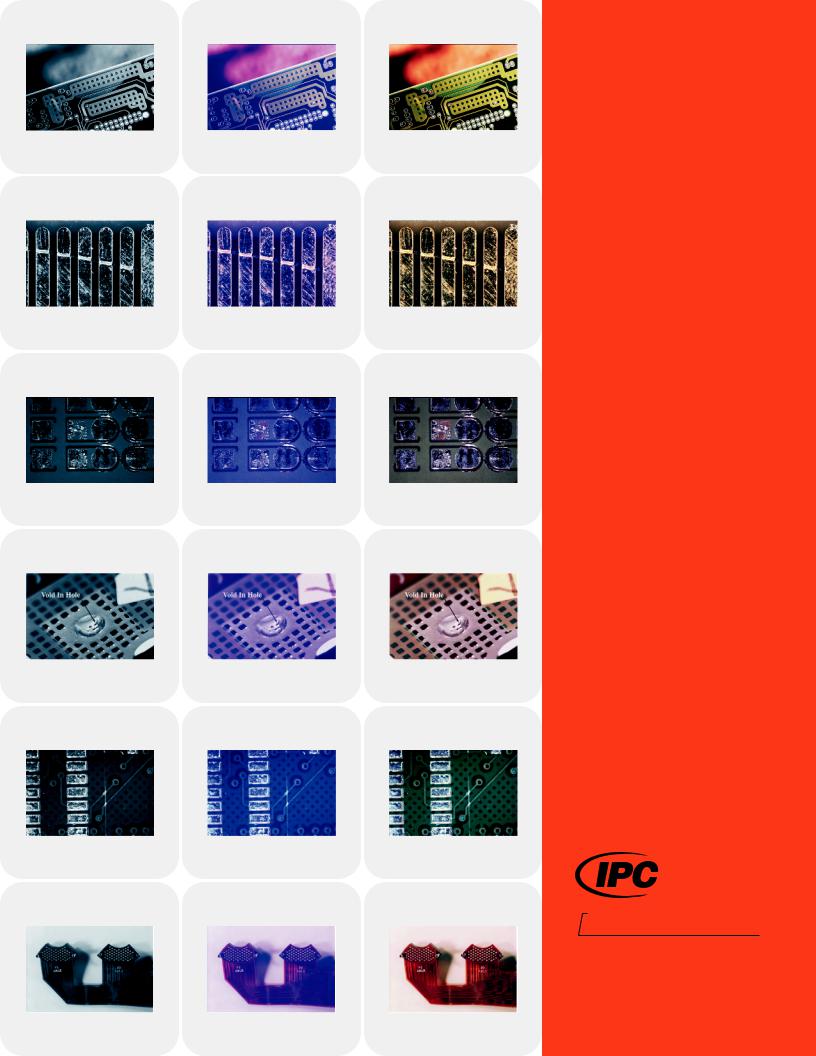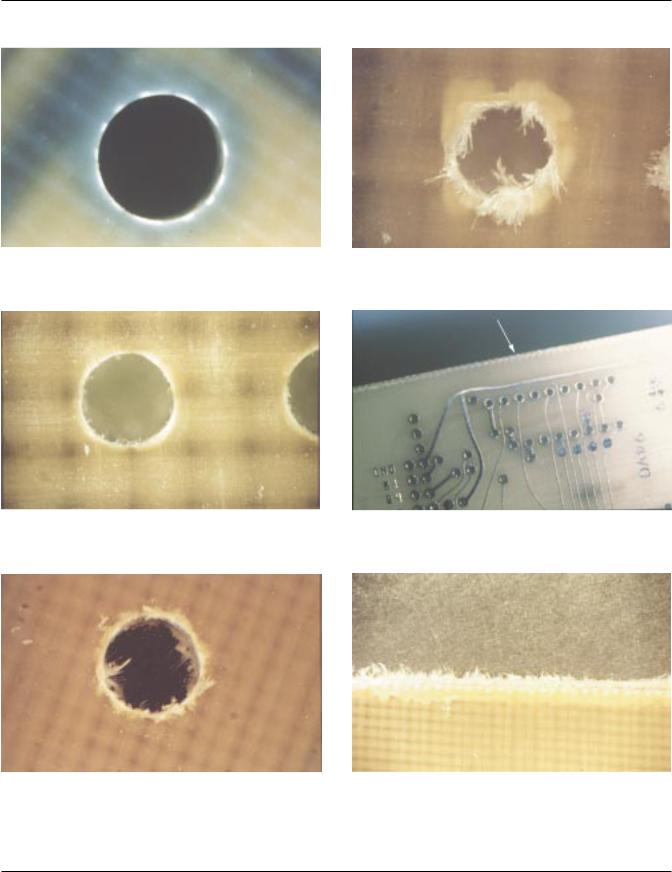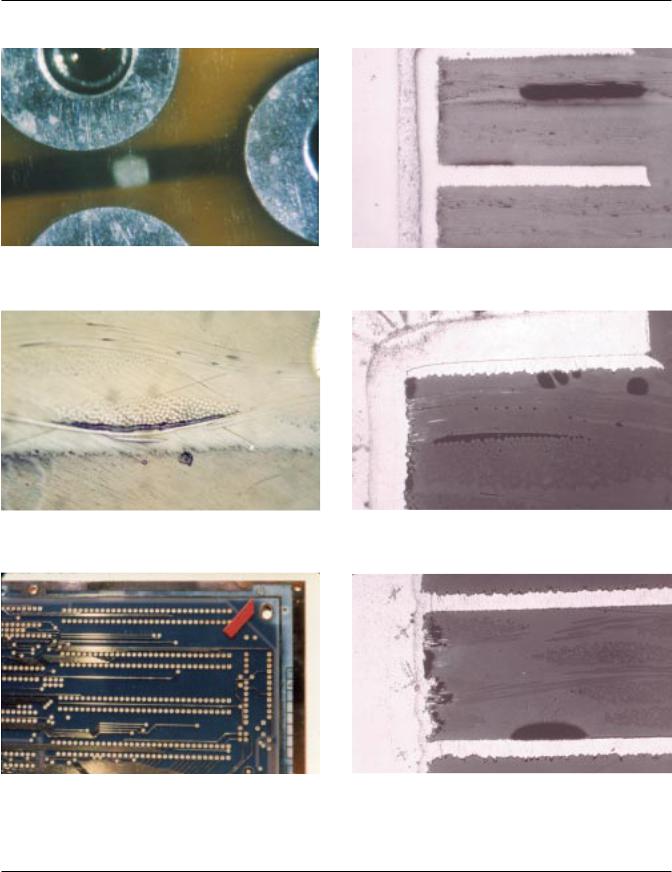
IPC-QE-605A.Printed board quality evaluation handbook.1999
.pdf
IPC-QE-605A
Revision A
February 1999
Printed
Board
Quality
Evaluation
Handbook
Developed by
ASSOCIATION CONNECTING ELECTRONICS INDUSTRIES

The Principles of
Standardization
Notice
Why is there a charge for this standard?
In May 1995 the IPC's Technical Activities Executive Committee adopted Principles of Standardization as a guiding principle of IPC's standardization efforts.
Standards Should:
·Show relationship to DFM & DFE
·Minimize time to market
·Contain simple (simpli®ed) language
·Just include spec information
·Focus on end product performance
·Include a feedback system on use and problems for future improvement
Standards Should Not:
·Inhibit innovation
·Increase time-to-market
·Keep people out
·Increase cycle time
·Tell you how to make something
·Contain anything that cannot be defended with data
IPC Standards and Publications are designed to serve the public interest through eliminating misunderstandings between manufacturers and purchasers, facilitating interchangeability and improvement of products, and assisting the purchaser in selecting and obtaining with minimum delay the proper product for his particular need. Existence of such Standards and Publications shall not in any respect preclude any member or nonmember of IPC from manufacturing or selling products not conforming to such Standards and Publication, nor shall the existence of such Standards and Publications preclude their voluntary use by those other than IPC members, whether the standard is to be used either domestically or internationally.
Recommended Standards and Publications are adopted by IPC without regard to whether their adoption may involve patents on articles, materials, or processes. By such action, IPC does not assume any liability to any patent owner, nor do they assume any obligation whatever to parties adopting the Recommended Standard or Publication. Users are also wholly responsible for protecting themselves against all claims of liabilities for patent infringement.
Your purchase of this document contributes to the ongoing development of new and updated industry standards. Standards allow manufacturers, customers, and suppliers to understand one another better. Standards allow manufacturers greater efficiencies when they can set up their processes to meet industry standards, allowing them to offer their customers lower costs.
IPC spends hundreds of thousands of dollars annually to support IPC's volunteers in the standards development process. There are many rounds of drafts sent out for review and the committees spend hundreds of hours in review and development. IPC's staff attends and participates in committee activities, typesets and circulates document drafts, and follows all necessary procedures to qualify for ANSI approval.
IPC's membership dues have been kept low in order to allow as many companies as possible to participate. Therefore, the standards revenue is necessary to complement dues revenue. The
price schedule offers a 50% discount to IPC members. If your company buys IPC standards, why not take advantage of this and the many other bene®ts of IPC membership as well? For more information on membership in IPC, please visit www.ipc.org or call 847/790-5372.
Thank you for your continued support.
©Copyright 1999. IPC, Northbrook, Illinois. All rights reserved under both international and Pan-American copyright conventions. Any copying, scanning or other reproduction of these materials without the prior written consent of the copyright holder is strictly prohibited and constitutes infringement under the Copyright Law of the United States.

IPC-QE-605A
Printed Board Quality
Evaluation Handbook
Developed by the Bare Board Visual Support Task Group (7-31c) of the Product Assurance Committee of IPC
Users of this standard are encouraged to participate in the development of future revisions.
Contact:
IPC
2215 Sanders Road Northbrook, Illinois 60062-6135
Tel 847 509.9700 Fax 847 509.9798

IPC-QE-605A |
February 1999 |
|
|
Acknowledgment
Any document involving a complex technology draws material from a vast number of sources. While the principal members of the Bare Board Visual Support Task Group (7-31c) of the Product Assurance Committee (7-30) are shown below, it is not possible to include all of those who assisted in the evolution of this document. To each of them, the members of the IPC extend their gratitude.
Product Assurance |
Bare Board Visual Support |
Technical Liaison of the |
Committee |
Task Group |
IPC Board of Directors |
Chairman |
Chairman |
|
Mike Hill |
Ron Thompson |
Stan Plzak |
Viasystems |
NSWC-Crane |
Pensar Corp. |
|
|
|
Bare Board Visual Support Task Group |
|
|
Nanci J. Baggett, Dell Computer |
Stephen Korchynsky, Lockheed |
Scott S. Opperhauser, Trace |
Corporation |
Martin Corporation |
Laboratories - East |
Larry R. Breeden, Nelco Arizona |
Richard Lundy, Lockheed Martin |
Mark Pritchard, IPC Video |
Floyd L. Gentry, Sandia National |
Astronautics |
Jim D. Raby, Soldering Technology |
|
||
Labs Albuquerque |
James F. Maguire, Boeing Defense & |
Int'l. |
Steven A. Herrberg, Raytheon |
Space Group |
Lowell Sherman, Defense Supply |
|
||
Systems Company |
Susan S. Mansilla, Robisan |
Center Columbus |
Ralph J. Hersey, Ralph Hersey & |
Laboratory Inc. |
Joseph T. Slanina, AlliedSignal |
|
||
Associates |
Daniel J. Nelson, Coates/ASI |
Aerospace |
Ted J. Jones, NSWC - Crane |
Bob Neves, Microtek Laboratories |
|
ii

February 1999 |
IPC-QE-605A |
|
|
Printed Board Quality Evaluation Handbook
INTRODUCTION
``QUALITY'' is a term used in such a variety of contexts and applications, that it is not a simple matter to de®ne.
·For some it means THE VERY BEST PRODUCT POSSIBLE.
·For others it means A PRODUCT QUALIFIES FOR A JOBÐAND IS WORTH THE PRICE.
·For still others, it simply means: MY PRODUCT IS BETTER THAN YOURS
One thing seems clear. If your company is to compete effectively in today's world market, you need to know what ``QUALITY'' means to your company. Economic reality dictates that there is a difference in a PWB on a spacecraft vs. an inexpensive toy.
Finding words to describe your company's philosophy on quality is not an easy task. It is even more difficult to communicate this meaning to your people. To do the job right, you need to do more than communicate a general concept of ``QUALITY,'' you need to inform your people as to how it impacts each element of your production process and your ®nal product.
A key ingredient in the success of your company to produce the quality you want requires that your inspectors and your processing people fully understand and have a realistic awareness of what quality actually ``looks like.''
To help you in this most important educational need, the IPC has provided a CD-ROM depicting a wide variety of photographic illustrations of various anomalies and characteristics of printed wiring boards.
In addition, IPC has provided this booklet, which is designed to help you utilize the CD-ROM.
While we have provided photographic illustrations of characteristics of PWB'S, we have not indicated any speci®c evaluation of acceptance or rejection. This is your job! Once you are able to obtain a consensus as to what each slide means to your company, you can begin a training program to educate your people to the appropriate awareness of quality.
HOW TO USE THIS HANDBOOK
As we indicated in the foreword, the material contained in the CD-ROM consists of photographic illustrations of various anomalies and characteristics of printed wiring boards.
The intent of this CD and handbook is not to pass judgement on whether a printed wiring board product is able to meet the performance requirements of the end item equipment, but rather to identify those anomalies that are some-
times seen during the inspection and evaluation processes. It is up to the user of this handbook/CD set to determine speci®c accept/nonconforming criteria for the anomalies contained in this evaluation set.
This handbook has been designed in a manner where only titles of the individual photographs and illustrations have been provided. No comment, as to the acceptability of the product based on the illustration, has been put forth since what is acceptable for one product could be a rejectable item for another.
Users are encouraged to take the standard IPC CD-ROM, ``IPC-CD-605,'' and review these photos with key individuals responsible for evaluation of the product.
Communication should take place between individuals participating in a training exercise, and if necessary cross referencing between various photographic illustrations can be accomplished using the numbering system. Each number is unique, and pertains only to one photograph.
Discussion leaders may wish to break the training programs into various segments. For this purpose, the CD-ROM, and this companion handbook, have been segmented into different sections. These sections are identified as:
SECTION TOPIC
AHandling/Damage
BLaminate
CConductor characteristics
DSurface plating
ESolder coating
FRegistration
GPlated-through holes
HMachining
JFlatness
KSolder resist (mask)
LMarking
MRigid multilayers
NFlexible/Rigid-¯ex
P Miscellaneous
It is also appropriate to assemble a set of photos that relate to a speci®c problem and may cut across the various groups. Discussion leaders are encouraged to make an agenda for such a meeting, identifying those photos which will be discussed and relate to a speci®c problem being experienced at the time. It is suggested that when such an agenda is prepared, in addition to providing the order in which the photos will be presented during the discussion, the discussion leader should also provide the corresponding page numbers of this manual. If necessary, in order to simplify the discussion, photocopies may be made which can
iii

IPC-QE-605A |
February 1999 |
|
|
be used to isolate and focus on the subject being discussed without drifting into other discussions related to other problems identi®ed within this handbook.
CAUTION TO THE READER
In addition to the condition described in the caption, some of the photos may have other undesirable/nonconforming conditions that are not discussed.
Further, some conditions can not be de®nitively categorized by examining one photograph. Examples of conditions that may need additional views or evaluation include:
·Resin smear vs. innerlayer separation
·Missing vs. variations in appearance of bond enhancement treatment
·Visual interpretation of subsurface defects (i.e., measles vs. delamination vs. laminate voids)
iv

February 1999 |
IPC-QE-605A |
|
|
A Ð HANDLING/DAMAGE
A±1 Finger prints on copper foil (left side)
Smudge (right side)
A±2 Wrinkled ¯ex
A±3 Corner damage
1

IPC-QE-605A |
February 1999 |
|
|
B Ð LAMINATE
B±1 Unsupported hole |
B±4 Unsupported hole |
Haloing |
Haloing/severe mechanical damage |
B±2 Unsupported hole |
B±5 Haloing along edge |
Haloing/slight mechanical damage |
|
B±3 Unsupported hole |
B±6 Haloing and nonmetallic burrs along edge |
Haloing/severe mechanical damage |
|
2

February 1999 |
IPC-QE-605A |
|
|
B Ð LAMINATE (continued)
B±7 Delamination |
B±10 Delamination |
B±8 Laminate voids |
B±11 Crazing |
B±9 Laminate voids |
B±12 Measle over inner layer conductor |
(Possible measle) |
|
3

IPC-QE-605A |
February 1999 |
|
|
B Ð LAMINATE (continued)
B±13 Measled board |
B±16 Laminate void in thermal zone |
(Board edge view) |
|
B±14 Measle |
B±17 Laminate voids in thermal zone |
(Cross-section) |
Measle |
B±15 Resin starvation |
B±18 Laminate void and resin recession |
4
